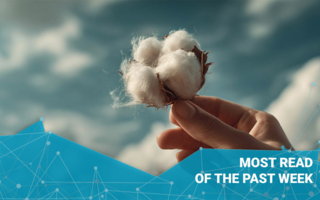10/07/2018 – Lectra — auf Deutsch lesen
It’s so important to take those first vital steps!
Online shopping, big data, networked machines. Holger Max-Lang, Managing Director Lectra Germany answers our questions about digitization.
textile network: Mr Max-Lang, you were appointed Managing Director of Lectra Deutschland at the beginning of this year. What are your first impressions?
Holger Max-Lang: Very positive. I’ve known Lectra for many years – I’m very familiar with its customers and industries. I first started working for Lectra in 2002. I was based in Munich as an Account Manager Automotive; back then, we were responsible solely for the German and Swiss markets. Lectra Deutschland has since gone from strength to strength. Today, we operate in 24 countries in Central and Eastern Europe including Russia. In 2009, I became head of sales across all our markets – automotive, furniture and fashion – and in the years that followed, I built up a close relationship with our team. In September 2017, I became Global Business Development Director Automotive, and then I was offered the position of Managing Director.
textile network: Gazing into your crystal ball, which way do you think the apparel industry is moving?
Holger Max-Lang: There’s no doubt about it – we’re moving towards Industry 4.0. The market has been undergoing rapid change in recent years. Competition has become much fiercer and margins on clothing and fashion have been on the decline. At the same time, customers have become far more demanding. They expect quality at sensible prices coupled with short lead times. This trend is being shaped, above all, by the younger generation who is accustomed to shopping online and to comparing products and prices. This goes hand in hand with the desire for customised products, that go above and beyond personalised drinking bottles. We’re talking here about clothing that is perfectly tailored to your own measurements; or furniture that not only reflects your personal colour and design preferences but has also been made to measure so that it fits into the tightest corners and niches of your home. Of course, it has also got to be affordable for the average consumer. The step towards a digitalised, networked industry is equipping the apparel sector with the tools it needs to meet these customer requirements.
textile network: What does Industry 4.0 actually look like in the apparel industry?
Holger Max-Lang: Networked. And by that, I mean everyone – the customer, logistics, suppliers, raw material providers, right the way through to the design and development teams. Connected by a smooth digital data flow via shared platforms – with no media disruption. All this goes hand in hand with smart machines and systems that not only manufacture but also manage inventories and adapt flexibly to the most diverse of requirements. This is all founded on data that connects the networked supply chain. These are the pillars of tomorrow’s textile industry. We’re also moving towards mobile production lines. I’m thinking here, for example, of container solutions in conjunction with pop-up stores – enabling customised production for local sales, made possible by networked automation and robotics.
textile network: Are German companies in the apparel industry well equipped for this development?
Holger Max-Lang: Many companies in the industry have already taken the first few steps in the right direction by defining and implementing digitalisation strategies. Many areas of the fashion industry are already benefitting from state-of-the-art technologies. Even so, there is still plenty of potential for automation and digitalisation on the one hand, and for networking processes and data flows on the other. A digital supply chain opens the door to a great many opportunities. How can products be designed and developed more quickly? How can manufacturing and production volumes be better aligned to expected sales or respond more flexibly to unexpected demand? These are all questions that need to be answered, yet many apparel makers are yet to ask them.
Of course, we shouldn’t kid ourselves. Digital transformation in the apparel industry won’t happen overnight. Even so, it’s important that companies start tackling it. If they don’t, many of them will disappear from the market within the next few years. The need among companies to catch up with progress can also be seen as an advantage. After all, it gives many firms the opportunity to make the right choices from the outset and to combine the best of today’s technology with that of tomorrow. In addition, the trend towards customisation and small production lots offers huge potential for sourcing apparel in Eastern Europe rather than in the Far East – which, in turn, has a positive impact on enhancing quality and margins.
textile network: Can you give us any examples of pioneers in the realm of digitalisation?
Holger Max-Lang: Particularly the big corporations such as Adidas are demonstrating what is already possible. With concepts such as the Speedfactory and the “Knit for You” Storefactory, the company has already shown and implemented pioneering examples of customised mass production. There’s still a huge gulf between the heavyweights of the industry and SMEs. Some manufacturers are trailing several years behind. Others, including our customers in the fashion industry, are well on their way to embracing digital production. It’s so important to take those first vital steps.
textile network: What are the greatest obstacles to the digital transformation?
Holger Max-Lang: The biggest hurdle is breaking up old entrenched structures. The clothing industry is steeped in tradition. The textile supply chain has barely changed in recent decades which means that processes are deeply embedded. Fabrics still have to be ordered a year in advance with a minimum square meterage. Many suppliers are still using machines that are ten to twenty years old and many production steps are still carried out by hand, most of which could have been automated years ago. These are all long-winded and inflexible processes that no longer live up to today’s market expectations.
textile network: So, what needs to change?
Holger Max-Lang: Attitudes within companies. Industry 4.0 isn’t an end in itself and it certainly doesn’t just happen of its own accord. Of course, not every company has the same amount to gain from it, but it certainly brings opportunities for everyone – it constitutes a chance to optimise production and to try out new business models. It’s important to be open to these changes and to seize the opportunities arising from them. It’s always helpful to network – not only in the technological sense. It’s the responsibility of every member of the industry to move in the same direction – from the supplier and manufacturer right the way through to the fashion brands. We, at Lectra, see ourselves as a partner, successfully guiding companies along the path to digitalisation and Industry 4.0 – the technologies are already at our finger tips, they just need to be implemented.
Mr Max-Lang, many thanks for talking to us.
The questions were asked by René Sohler on behalf of textile network




